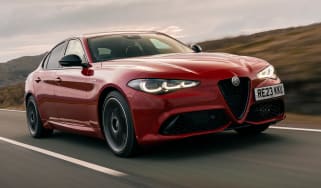Mitsubishi Lancer Evolution 10 – the car world's greatest misses
The Mitsubishi Evo 10's attempts to be more serious and grown-up are where it all went wrong for the hot Lancer, says Richard Porter...

The first nine parts of the Mitsubishi Evo dynasty played very well around these parts. It was the car so good they named it after this magazine. Probably. In fact, evo cottoned on to the steroidal Lancer family around chapter six, back when getting one meant importing it from Japan.
As a result, no one bought one of these cars by accident and that marked them out as machines for our kind of people.
To anyone not interested in cars an Evo VI looked like some gawky JDM saloon that had been to the Demon Tweaks fancy dress shop. But if you knew your stuff, the Evo was a rare groove treat and a bone fide homologation special to boot
People bought Evos because they saw what they could do in the hands of Tommi Mäkinen and because they knew that in order to make those title-winning rally cars possible, even the road going Evos had lightweight panels and fabulously over-engineered drivetrains. They knew something else too: real-world Evos were gloriously and hilariously brilliant to drive.
The fun started with that lusty, and highly tuneable, 2-litre four and continued with the way it delivered its headily boosted torque to the road through a four-wheel-drive system with a torque splitting set-up that Mitsubishi called Active Yaw Control. Put the two together and you had multiple generations of cars that were, without exception, hysterically fast absolutely everywhere.
Little wonder that when Mitsubishi UK began official imports of the Evo VIII it added a new badge, FQ, which it told Japanese head office was short for ‘Fine Quality’. This was a fib. What it actually stood for was Fucking Quick. Such cheekiness suited these cars because there was a silly, giddy quality to them that never failed to put a smile on your face.
Obviously you didn’t buy an Evo VII or VIII or IX for its Audi-alike interior quality because, though the mechanical parts felt as tough as tugboats, everything else was tacky crapulance along for the ride. As soon as that ride started, however, you didn’t care.

We were big fans of those old Evos here at evo, in particular the way they’d casually turn up on Car of the Year and duff up a couple of supercars or make an appearance at Bedford Autodrome and spend the afternoon drifting effortlessly through the last corner on the West Circuit. They were seriously talented but not too serious and we loved them.
Then they hit the reset button. The Mitsubishi Evolution X was, it said, all new. New engine, new chassis, and a new-found desire to be more serious and grown-up. This is where it all went wrong. The engine, while strong, also lost the personality of its predecessor, and the same was true of the chassis which seemed po-faced and less playful.
You could still cover ground at a lick but once you realised you weren’t having as much fun as in the old cars you started to zoom in on failings like the dreadful ride and dead-handed steering. Nor was the X the plush RS4-style everyday performance saloon it aspired to be and if you tried to use it like that the droning engine, useless infotainment, tiny fuel tank and wanton thirst soon made you wish you’d given your money to Audi.
As a final kicker, Mitsubishi had pulled out of WRC at the end of the 2005 season, two years before the X went on sale, so it wasn’t even a proper homologation special. Truth was, in trying to make the Evo better, Mitsubishi managed to make it worse.
This story was first featured in evo issue 322




